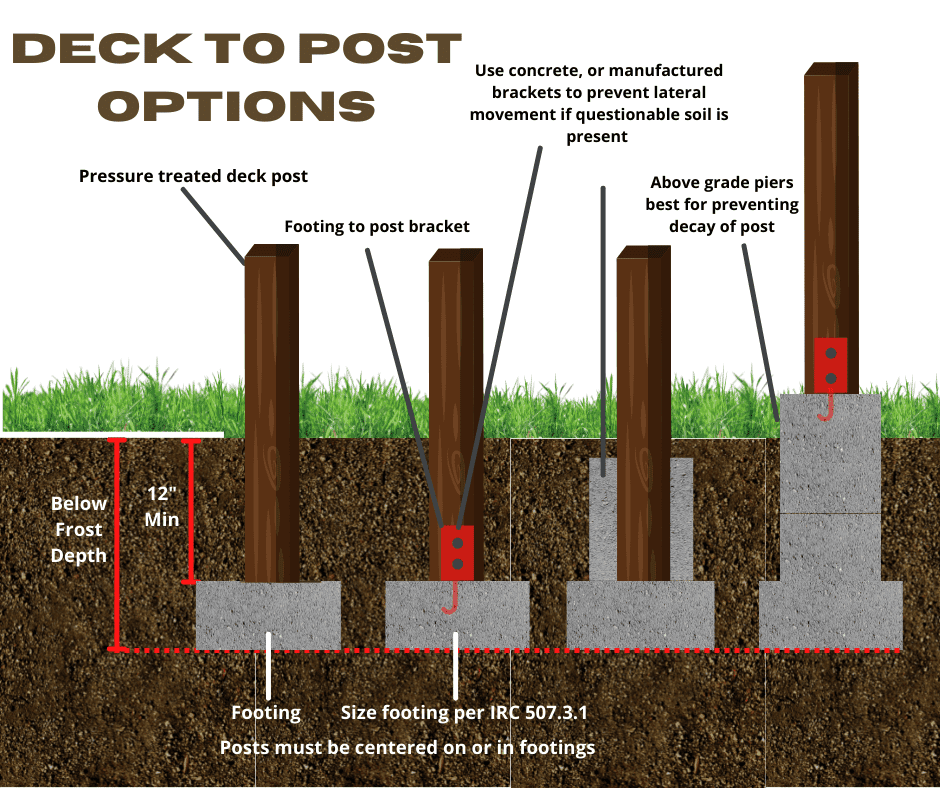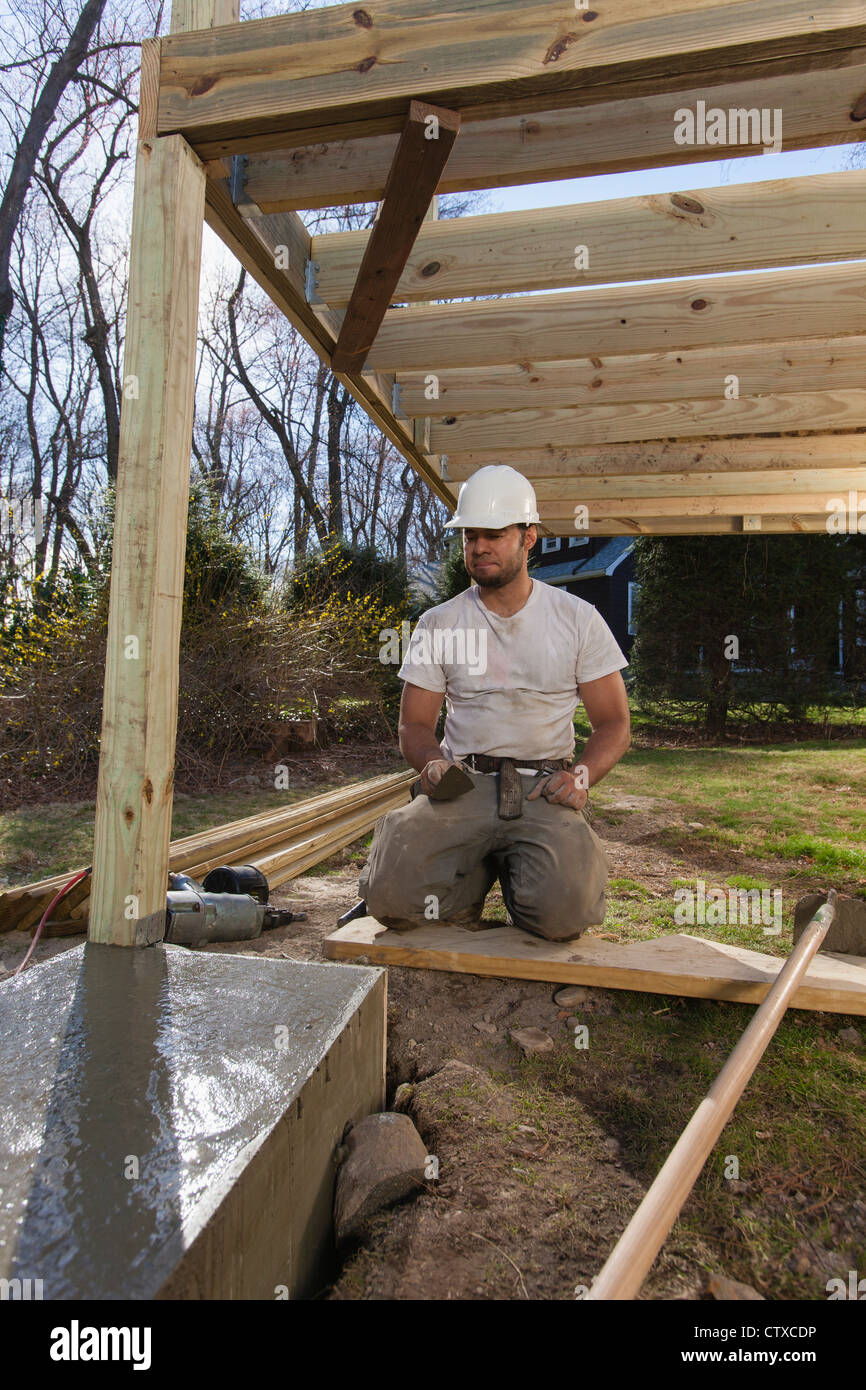Guarantee Stability and Durability With Correctly Mounted Deck Footings
Deck footings might not be the most attractive facet of deck building and construction, yet they play a vital function in guaranteeing security and longevity. In this conversation, we will certainly explore the importance of proper deck footings, variables to think about throughout installment, various kinds of footings available, detailed setup overview, and upkeep tips for guaranteeing long-lasting grounds.

Relevance of Proper Deck Footings
Why are effectively set up deck footings essential for the stability and durability of your deck? The response lies in the basic role that deck footings play in supporting the weight of the entire framework. Deck grounds are the structure on which the deck rests, moving the load from the deck to the ground. It can lead to a variety of issues that jeopardize the stability and longevity of the deck. when grounds are not effectively set up.
To start with, correctly installed deck footings disperse the weight of the deck equally, protecting against any kind of uneven settling or sinking. This is particularly vital in areas with unpredictable dirt, as it aids to mitigate the danger of the deck collapsing or moving. Additionally, well-installed footings ensure that the deck remains degree, stopping any kind of architectural damages that can occur when a deck ends up being unequal.
Secondly, correctly installed footings supply a strong support for the deck, stopping too much movement and persuade. This helps to maintain the architectural integrity of the deck, decreasing the threat of crashes or injuries. It likewise lessens the deterioration on the deck, permitting it to endure the elements and normal use for a longer amount of time.
Aspects to Consider for Deck Ground Installment
When mounting deck grounds, there are a number of crucial aspects to take into consideration for correct installment. These aspects can considerably influence the security and long life of your deck. Most importantly, you need to establish the sort of dirt on which the deck will certainly be constructed. Different dirt types have various load-bearing abilities, so it is vital to conduct a dirt examination to make sure the grounds can support the weight of the deck and its owners. In addition, the location and layout of the deck should be carefully prepared to stay clear of any kind of challenges such as trees, energy lines, or below ground pipelines. It is likewise essential to consider the neighborhood environment and weather, as these can affect the longevity of the grounds. As an example, areas with a high water table may require additional actions to avoid water damage. The dimension and product of the grounds must be selected based on the size and weight of the deck, as well as the local building codes and laws. By considering these variables, you can make certain the correct setup of deck footings and appreciate a resilient and steady deck.
Types of Deck Footings to Pick From
There are numerous various types of deck footings readily available for you to pick from. Each kind has its own advantages and drawbacks, so it's vital to consider your specific demands and the conditions of your deck prior to deciding.
One usual kind of deck ground is the concrete ground. This includes excavating holes in the ground and putting concrete into them to produce a strong structure. Concrete grounds are resilient and supply outstanding security, making them suitable for decks in areas with tough dirt conditions or high wind lots.
One more option is the helical pier ground, which includes a steel shaft with helical plates that are screwed into the ground. These grounds are quick to set up and can be used in numerous soil types, consisting of sandy or clay dirts. They are likewise adjustable, permitting easy leveling of the deck.
Sonotube grounds are an additional preferred selection. These grounds are produced by placing a cardboard tube in an opening and filling it with concrete. Sonotube footings are relatively simple to set up and provide sufficient stability for smaller sized decks or in areas with much less requiring soil conditions.

When choosing the kind of deck footing, it's important to take into consideration variables such as dirt conditions, deck size and weight, neighborhood building codes, and individual choices. By picking the proper footing kind, you can make sure the stability and longevity of your deck.
Step-by-Step Guide for Putting Up Deck Footings

Identify the area: Begin by noting the precise placement of each footing making use of risks and string (Deck Footings). Consider any kind of neighborhood building regulations or policies concerning trouble ranges
Dig the holes: Utilize an article hole miner or an auger to dig the holes for the grounds. Usually, a deepness of at least 36 inches is recommended for stability.
Level the openings: Guarantee that the bases of the openings are level (Deck Footings). This can be attained by utilizing a degree or a straight board throughout the top of the openings
Add crushed rock: Area a layer of gravel at the end of each hole to boost drainage and avoid the footing from penetrating the dirt with time.
Put the ground kinds: Place the ground develops right into the holes, ensuring they are focused and level. Use risks to safeguard them in area.
Mix and put concrete: Adhere to the directions on the concrete mix bag to prepare the concrete. Pour the concrete right into the footing types, filling them completely.
Smooth the surface: Utilize a trowel to smooth the surface of the concrete and get rid of any air pockets. Permit the concrete to heal according to the supplier's directions.
Upkeep Tips for Resilient Deck Grounds
Proper upkeep is critical for making certain the longevity and security of deck footings. By frequently examining and preserving your deck grounds, you can stop damage and potential safety and security risks. next page One important aspect of upkeep is to routinely look for any type of signs of degeneration, such as cracks or movement in the grounds. If you observe any concerns, it is very important to resolve them promptly to stay clear of further damages.
Regular cleansing is additionally important for preserving deck grounds. Plant life, particles, and dirt can accumulate around the footings, which can bring about moisture accumulation and degeneration. Cleaning up the grounds consistently, making use of a stress or a brush washing machine, can help avoid these issues and expand the life-span of your deck.
In addition to cleansing, it is essential to maintain the location around the footings clear of any type of blockages. Avoid stacking products versus the grounds or allowing plants to grow too close to them. These obstructions can trap wetness and cause the footings to weaken gradually.
Finally, normal resealing of the footings is recommended to protect them from dampness and various other ecological factors. Using a waterproof sealant can help prevent water damage and expand the lifespan of the footings.
Verdict
Finally, proper installation of deck footings is crucial for making sure security and longevity of your deck. Factors such as dirt kind, load capacity, and neighborhood building ordinance require to be considered when picking the appropriate kind of deck grounds. Adhering to a step-by-step overview for installation and routine maintenance will certainly assist to ensure the footings remain sturdy and durable.
In this discussion, we use this link will certainly check out the relevance of my link appropriate deck grounds, factors to think about during setup, various kinds of footings readily available, detailed setup guide, and maintenance tips for guaranteeing long-lasting grounds. Deck footings are the structure on which the deck relaxes, moving the lots from the deck to the ground.One usual kind of deck footing is the concrete footing. Place the footing forms: Put the ground develops into the openings, guaranteeing they are centered and degree.In conclusion, appropriate installation of deck grounds is critical for guaranteeing stability and long life of your deck.